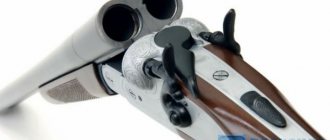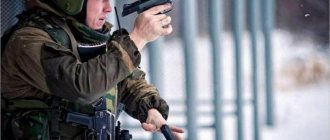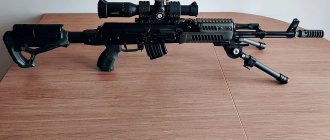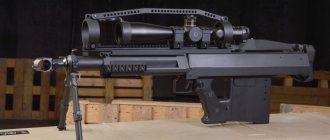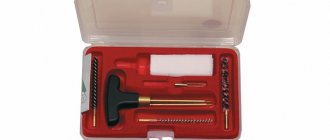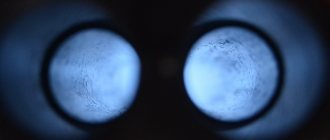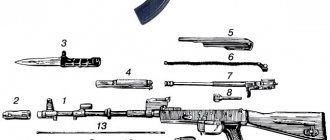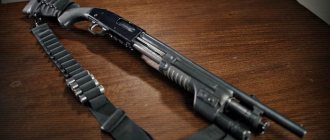None of the knowledgeable people will argue: cleaning weapons is a necessary matter. Regardless of whether we use it or it just sits in our closet, nevertheless, weapons tend to get dirty over time. Especially, of course, it gets dirty during use: during shooting, while hunting, and if it is a military weapon, then during battle.
This raises a whole list of questions: how to properly clean a weapon, what cleaning agents are best to use for this, how often cleaning is necessary, with what devices, etc. If we know why cleaning is needed and apply our knowledge in practice, our weapon will will serve us long and reliably.
How do weapons get dirty?
Naturally, weapons are most intensively contaminated as a result of shooting. It is also clear that the trunk is exposed to the greatest contamination. When fired, high pressure occurs inside the barrel. Residual products that are formed during the combustion of gunpowder and as a result of ignition of the primer are deposited on the inner surface of the barrel. These products affect the metal, and therefore the barrel, in the most destructive way. In addition, these deposits spoil the polishing of the barrel.
It should be remembered that potassium chloride, which is part of the primer, is much more harmful to weapons than gunpowder residues. When fired, its particles come into contact with the surface of the barrel, which is why at the points of contact the steel loses its original properties and becomes fusible. The powder gas generated during the shot melts the steel fragments and pushes them out. As a result, the inner surface of the trunk becomes rough, and a rash and small shells form on it. This process is known to gun owners as “bore-flashing.”
And this is not all the harmful effects of potassium chloride. It also has the property of drawing atmospheric moisture into the barrel, which causes the steel in the barrel bore to corrode and rust. In addition to potassium chloride, the primer contains mercury, the residues of which penetrate deep into the metal, resulting in microcracks that contribute to further deterioration of the barrel.
Due to the heating of the barrel during the shot and cooling after it, the chemical reactions that contribute to the heat of the barrel last from 3 to 5 days. If at the same time the weapon is fired intensively every day, then due to the friction of the bullet passing along the barrel, the process only intensifies. And it will get worse until the weapon is cleaned.
There are three main stages of cleaning weapons:
- pour alkaline oil (solvent) into the inside of the weapon;
- clean the weapon;
- lubricate the weapon.
Of course, when cleaning weapons of various systems, there are many features that must be taken into account.
Cleaning rifled weapons
Basic rules for cleaning rifled weapons:
- Rifled weapons should be cleaned in the following sequence: first the breech, then the muzzle. That is, in accordance with the direction of flight of the bullet;
- The cleaning rod should also move in the same direction - from the breech to the muzzle. In this case, it is recommended to change the patch (a special napkin rolled onto the wipe, called a visher) more often. The patch is a disposable device, so it is not recommended to use it repeatedly;
- It is not recommended to move the cleaning rod for cleaning weapons in the “back and forth” mode. This may cause scratches inside the barrel. Moreover, the brush and patch are easily clogged with particles deposited on the walls of the barrel;
- The brush for cleaning weapons should be chosen not soft, but hard. Soft bristles very quickly become clogged with hard carbon deposits settled inside the barrel, and it is very difficult to remove it from a soft brush. On the contrary, a brush with a stiff brush is much more effective in this sense, since it cleans the inside of the barrel more reliably. In this case, you need to ensure that the brush remains dry (as well as the patch), otherwise, again, residual particles in the barrel bore will stick to them;
- It is advisable to clean your weapon immediately after shooting. It is highly recommended not to postpone cleaning until the next day. The reasons for this requirement were discussed above;
- It is necessary to periodically clean the weapon even if no shooting has been done from it. In this case, the lubrication is not so intense;
- If the weapon was fired, then, as stated, it should be cleaned immediately after firing. After 2-3 days, the weapon must be cleaned again, and after another 2-3 days - a third time. And only then can rifled weapons be stored for a long time, but it should be remembered that even during long-term storage they must be periodically cleaned;
- It is most necessary to clean the muzzle part and the bullet entrance - as the most “easily damaged” parts of the barrel;
- When cleaning rifled weapons, it is very undesirable to use a variety of “homemade” products: homemade compounds, lubricants not intended for weapon cleaning. You cannot use homemade alkaline compounds; you also cannot immerse the weapon or its individual parts in highly alkaline solutions. Such an amateurish approach to cleaning weapons can simply ruin the weapon;
- After cleaning, the gun barrel, as well as all cleaned components and mechanisms, must be lubricated with gun oil.
To clean your weapon more efficiently, you can use a stand or a weapon cleaning machine. These are special devices on which the weapon is conveniently fixed. In addition, the machine and stand have special niches for storing gun oils and other cleaning and lubricating products. At the same time, the stand for cleaning weapons is very compact, so if you wish, you can take it with you even when hunting or to shooting sports competitions. You can make it yourself, or you can buy a branded one.
We buy a weapon - we buy a cleaning kit
Weapon cleaning kits may vary. For example, a gift set. This is a very beautiful set, but such a gift is unlikely to be suitable for frequent cleaning of weapons. Its distinguishing feature from other sets is its excessively high price. You should also be careful when using a universal gun cleaning kit. Experienced people advise that it is best to purchase a highly specialized kit designed for cleaning weapons of a specific caliber.
The ideal option is to buy a weapon and immediately clean it with a purchased cleaning kit. Moreover, newly purchased weapons must first be cleaned. A new weapon must be depreserved (that is, the factory grease must be removed), the firing mechanism, as well as the entire weapon must be cleaned. After zeroing, which must be carried out without fail, the weapon should also be cleaned. In short, a cleaning kit is a must; it’s hard to do without it.
In the future, the weapon must also be cleaned at regular intervals. If the weapon is not in use and is in a safe, it must be cleaned at least once a month. When a weapon is used (hunting, target shooting, self-defense, etc.), it must be cleaned every time after use.
Cleaning smoothbore weapons
Smoothbore weapons, like all other types, need to be cleaned. It is important to know the frequency of cleaning such weapons. There are many opinions on this subject, but most knowledgeable people say that smoothbore weapons should be cleaned at least monthly - even if they have not been fired or taken out of the safe.
However, there are situations when weapons need to be cleaned more often:
- After purchasing a gun – especially a new one;
- After the gun has been zeroed;
- After each day spent hunting;
- After the hunting season is over.
After purchasing the gun, you need to clean it to remove the factory grease, and also check how the gun is assembled and whether there are any defects in it. During the zeroing process, the gun must be cleaned after each shot. This will help determine how accurate the gun is. When it comes to cleaning a gun during a hunt, everything is clear and without explanation: it is during hunting that the gun gets dirty the most. Well, during the “dead season” the gun is cleaned for preventive purposes: during storage in the closet, moisture may accumulate in the weapon.
Smoothbore weapons are cleaned in the following sequence:
- First, the barrel is broken or dismantled (depending on the design of the weapon);
- A brush screwed onto a cleaning rod is passed over the inside of the table to remove substances harmful to the weapon that were formed during shooting from the barrel;
- You need to change the brush on the cleaning rod to a brush into which the patch is inserted, and with the help of such devices the barrel is cleaned until there are no signs of soot or soot left in it. In this case, the patch needs to be changed periodically;
- If several rags have already been replaced, but traces of burning are still not completely removed, then in this case the rag should be moistened with turpentine or kerosene;
- After the contamination from the barrel has been completely removed, a brush with stiff bristles is put on the cleaning rod, onto which a universal or neutral lubricant is previously applied, and the entire inside of the barrel is covered with this lubricant;
- From the outside, dirt is removed from the entire body of the weapon, after which the body must be lubricated with a thin layer of lubricant;
- The wooden parts of the weapon are also cleaned of dirt and lubricated;
- After this, the gun must be collected and stored in a safe.
When cleaning, care must be taken to ensure that no moisture gets into the barrel. If a weapon is cleaned in winter, then in this case the gun is allowed to “sweat” by wrapping it in a warm rag.
However, all this is good if the weapon is not rusty, but if it has already begun to rust, then more radical means are needed. In this case, the barrel is cleaned using a metal brush and a hard brush. In this case, the brush and brush, as well as the rod for cleaning the barrel, are moistened with dehydrated kerosene. If there is a lot of rust and it is old, then kerosene should be poured into the barrel, the barrel itself should be plugged with a tight plug, and everything should be left like that for 24 hours. After this, the barrel needs to be cleaned using the same brush and brush.
But if rust has formed on the outside of the weapon, then waterproof glue can come in handy. First, use a hot soda solution to wash off all the grease from the gun. Then the glue is diluted in hot water, and this substance is applied to the surface of the weapon - to the part where the rust appeared. The glue dries instantly, after which a universal lubricant is applied to the treated surface.
Even if such a product does not cope with the rust, you can try to remove it by preparing the following solution:
- Ammonium sulfate – 28 g;
- Ammonium carbonate – 13 g;
- Ammonia water – 170 g;
- Distilled water – 100 g.
The prepared solution must be poured into the barrel, plugged into the barrel on both sides, hold the solution in the barrel for half an hour, then remove it, wipe the barrel dry and lubricate it with alkaline oil.
Effective cleaning of weapons: we do without expensive imported chemicals
PHOTO SHUTTERSTOCK
The situation has been alleviated by the fact that domestic manufacturers have begun to appear, but unlike foreign ones, which have been known for a long time, domestic ones cause a certain mistrust, and the prices for our chemicals, although lower, are still high.
What remains for our hunter?
Let us remember how and with what our ancestors cleaned weapons, and take a closer look to see if there is anything suitable for our purposes among other chemicals, household or automotive.
Honestly, I have long wanted to get off the needle of expensive weapons chemicals, and at some point I came to the conclusion that the combination of two products covers almost 90% of the needs.
I’ll share my experience: after shooting or being outside for a long time, especially during a humid period, I simply fill the barrel, or even all metal parts, with WD-40.
This product is sold in any store in the form of a spray, in convenient packaging from 50 to 400 g. It is a little expensive, but several times cheaper than American chemicals.
Its positive properties are to completely displace water from the metal, protect it and soften carbon deposits. After this, the barrels are much easier to clean.
It should be used after shooting or after hunting, before putting it in a case for transportation home or to the base.
A nice bonus: WD-40 preserves the weapon, and you can clean it not immediately upon arrival home, but after a day or two. As practice has shown, unlike most oils, it does not harm wood.
Before cleaning, I simply remove the WD-40 by wiping the gun with a rag.
Read the material “TO-1 or what to do with a new gun”
I know that many hunters do not accept washing weapons with boiling water, but believe me, this is one of the cheapest, simplest and most effective ways to clean a weapon from dirt, carbon deposits and oil. This method is especially good for weapons that are easy to disassemble and allow you to separate the metal from the wood.
Incidents happen. For example, the seemingly complex SKS is well suited for such a procedure, since it can be disassembled simply and quickly, but the TOZ-34 is inconvenient, since the linings from the barrels can only be separated with a screwdriver, and even then if the weapon is not fired.
| Keeping your gun clean takes a lot of effort and sometimes costs. PHOTO BY ANTON ZHURAVKOV |
So, take a bucket or small basin made of material that is not afraid of heat. Pour boiling water, dissolve ordinary laundry soap in it and get a slightly alkaline solution.
We take the trunks through a potholder, as they will heat up, quite strongly (if not, it means the water is too cold). Heating not only simplifies washing, but also allows the trunks to dry instantly after the procedure.
Many people are afraid that the weapon will rust if it comes into contact with water. No. If the water was hot, the metal will heat up and dry in just five minutes.
I pour the barrels straight from the kettle, they heat up, I insert a cleaning rod with a thick visor into the barrel and start cleaning. The cleaning rod, like a piston, sucks in water and pushes it out.
With each movement, the water and soap are renewed and all the dirt is washed into the bucket. The process takes no more than five minutes, and literally everything is washed off: carbon deposits, lead, and any dirt.
If you have never washed your barrels before, you will be surprised by the result; they will shine like new.
True, many people notice defects in trunks that they had not seen before. The fact is that after cleaning with oil, you may simply not notice a small rash that is just beginning to appear; it is masked by the oil itself. After washing, as soon as the trunks are dry, everything becomes visible.
Probably, this feature gave reason to believe that washing could damage the trunks. But I’ll note again: it can’t cause damage, but it can easily reveal shortcomings. To check this, lubricate the barrels again and make sure that the small rash “disappears”, just remember: these are all illusions...
Read the material “Choke tubes and flying shots”
By the way, washing the barrel is almost the only option for cleaning weapons after firing black powder, which covers the barrels with soot. Cleaning out soot using the traditional method is long and painful.
The savings on chemistry, and especially on patches, especially if you continue to use imported ones, are colossal. We even joked: what’s the point of saving money by equipping cartridges with a smoker yourself, if you then spend more money on chemicals and patches?
| An alternative to expensive chemicals can be products from Chinese manufacturers. PHOTO BY ANTON ZHURAVKOV |
By the way, about patches. Of course, imported or even domestic ones made of cotton fabric, “barrels” made of felt or polyurethane are good, you can’t say anything. They clean well, choose between cuts well, but the price!..
Today they cost so much that you want to use sheets or grandfather’s felt boots for patches. This is possible, but it’s easier to take napkins made of non-woven material, which are sold in any store, hardware store or chain store like Auchan or Pyaterochka; they cost about 200 rubles per roll.
Yes, they have disadvantages, yes, they clean worse, but they absorb oil well and apply it well to the surface of the barrel. If you clean them traditionally, they take more than “classic” patches, but if you wash your weapon as I described above, then you only need two of them.
So, we washed the gun, poured boiling water over it to wash away the soapy solution and heat it up as much as possible, drained and shook off the water and laid it to dry. Usually the moisture disappears right before your eyes, the barrel with the box becomes absolutely dry and clean. Now all that remains is to lubricate it with oil.
You need to lubricate everywhere. Of course, spray oil is very convenient, but there are affordable options. I have tried various oils, from gun oils to automotive oils. Ballistol or Brunox, of course, rule, but their price is inhumane.
I tried sewing machine oil. As he writes, but we don’t need that. For our purposes, the best option is automobile oils. Although they contain additives, these additives, as they say, are on point.
Practice has shown that good synthetic oil of any brand is suitable. It is somewhat thicker than gun grade, so it is recommended to use the thinnest one, something like 5W-40 or the like. It displaces water, which is a big plus.
Read the material “Suppressor for rifled and smooth-bore weapons: what you need to know”
In general, the short recommendation looks like this: we shot, filled in with WD-40, which displaced and protected everything we could, arrived, wiped it off and washed it with boiling water and household soap, dried it and treated it with oil.
The most expensive component in this scheme is WD-40, but I don’t see any point in abandoning it, it is needed both in the car and in everyday life...
| PHOTO BY ANTON ZHURAVKOV |
The scheme that I described seems to me universal and correct. She performed especially well in working with weapons after shooting with black powder.
It has been noticed that if you clean a weapon traditionally, then after a couple of days you can run the patch through the barrel and it will not come out white at all, but in a washing situation the patch always comes out clean.
Other weapon parts, including trigger parts, can also be washed well with soapy water. Of course, we are talking about weapons that are easily disassembled. It is highly not recommended to disassemble the block of double-barreled guns.
At one time, it was a real problem to clean the gas piston of the Saiga from carbon deposits, where the burning is especially strong and, although the piston itself is chrome-plated, it is very difficult to clean it. It turned out that soaking in Coca-Cola gives good results.
This has no effect on chrome; It is not recommended to shove polished steel parts into this hellish drink, which become gray and lose their presentation.
Read the material “Making a high-quality knife from a saw in two and a half hours”
What should absolutely not be brought near a weapon is a rust converter. I read that it removes carbon deposits well and that it can remove rust from barrels. Maybe. But it also removes bluing perfectly, and with just one movement you can turn a black part into gray.
There are also recommendations for apologists of traditional cleaning, in which barrels are cleaned by sequentially running patches through the barrel with various solutions, first cleaning, then lubricating.
It turns out that car dealerships sell interesting and relatively inexpensive chemicals that can remove carbon deposits, copper plating and lead, but we will talk about it in the next article.
Semyon Morozov January 25, 2022 at 12:48 pm
Airgun cleaning
Pneumatics also need cleaning. Not as often, of course, as rifled or smooth-bore weapons - but still less so. The air rifle also gets clogged, and in addition, its charges also leave a mark inside the barrel. In addition, pneumatic barrels are not as high quality as those of other weapons; the steel used to make them is relatively soft, and for this reason such barrels rust easier and faster than those of hunting rifles.
Cleaning an air rifle is necessary in the following cases:
- Between 100 and 200 shots;
- When the rifle’s accuracy decreases (the rifle begins to “spit”);
- When smoke and sparks are visible from the barrel when fired.
You can start cleaning the pneumatic barrel from either end. The process of cleaning the “air” consists of four main stages: removing lead deposits inside the barrel, degreasing the barrel, drying and lubrication. After this, the cleaned weapon must be lubricated. When lubricating a pneumatic barrel, some rather specific nuances should be taken into account.
In principle, lubricant for an air gun is needed “to the extent”, but still the charge moves through a lubricated barrel more easily. However, if the barrel is over-lubricated, the accuracy of the combat will decrease in this case (the rifle, again, will “spit” in different directions). It is best to lubricate the barrel with some neutral gun oil. Moreover, in an extremely thin layer.
Cleaning 12 (16, 20) gauge weapons
To clean 12, 16 and 20 gauge weapons, in general, you will need the same set of tools and tools as described above. And the sequence of cleaning and lubricating the barrel and individual components is the same.
The only “know-how” here is that many experts and practitioners advise cleaning the barrel of a gun not with a rag, but with a ball made of toilet paper. Such a ball is driven into the barrel and pushed along the entire length of the barrel using a cleaning rod with a brush mounted on it. It is claimed that toilet paper is much better at cleaning the barrel than rags. For an ideally positive result, it is recommended to clean it with several of these balls.
However, at present, special devices for cleaning weapons of any caliber have appeared in gun stores.
What does a standard gun cleaning kit consist of?
Most often, this set includes:
- Ramrod. In the set it can be brass or wooden. The most common type is a brass cleaning rod. A wooden cleaning rod is a rarity; it is usually intended for cleaning either very old or especially valuable weapons. The cleaning rod comes in two varieties: with external or internal thread;
- Vishers. Vishers are specially made loops into which rags are threaded for cleaning;
- Metal brushes. There may be many of them in a set. They are designed for cleaning all kinds of places in weapons that are difficult to access;
- Brush with bristly bristles for cleaning the trunk;
- Puff;
- Cord cleaning rod. This accessory may not be included in every set.
All sets differ from each other in their cost: the more expensive the set, the better quality it is (except, perhaps, for gift sets). If the weapon is used frequently, then it is better to purchase a more expensive set, but if from time to time, then a cheap set will do just fine.
Weapon cleaning products
Over the entire existence of firearms, innumerable devices have been invented for cleaning them, ranging from the most primitive to the most modern, which can be found in the catalog. We won’t talk about ancient methods like cleaning the bore with crushed bricks here. Let's talk about some of the most popular modern means for these purposes:
- German-made gun oil Ballistol 50 ml (liquid);
- Gun oil of the same production Gunex 2000 200 ml in the form of a spray. Cleaner for cleaning dirt inside the barrel Robla Solo MIL 100 ml in liquid form. Made in Germany. All three of these products are included in the kit with which you can clean and preserve weapons;
- For the same purposes, there is also an American BIRCHWOOD-CASEY Value Pack;
- Foam for cleaning weapons. Actually, the global chemical industry has produced a lot of foam samples for these purposes. For example, Armatech 210 ml made in Russia. Or - Schmeisser 200 ml made in Germany. And so on;
- A product for cleaning weapons from soot and soot, as well as for protecting against corrosion, Ballistol Robla Solvent. The solvent is available in the form of an aerosol, and perfectly cleans the barrel - especially when using charges with black powder. In addition, the solvent has excellent corrosion resistance;
- A set for cleaning weapons with a special flexible snake, and weapons exclusively of 12 gauge. Made in the USA;
- Alkaline composition "Taiga" made in Russia. It is remarkable because it can be used to effectively clean any weapon - rifled, smooth-bore, pneumatic. At the same time, its cost is very small.
This list could be continued, but it’s better to look at the catalog and choose a product that suits your taste and budget.
To summarize, we can say that cleaning a weapon is the most important condition for it to serve faithfully for many years.
The need to purchase a weapon cleaning kit
Many gun owners believe that cleaning a gun is a trivial matter, and there is no need for any wisdom, special knowledge or skills. However, this is a serious misconception. Cleaning weapons must be taken seriously, otherwise an uncleaned weapon can cost its owner his life.
Of course, when cleaning weapons, you can get by with all kinds of rags and other auxiliary means, but it is better to purchase a special kit for cleaning weapons. Moreover, its price is relatively low, and the choice, on the contrary, is almost limitless.
